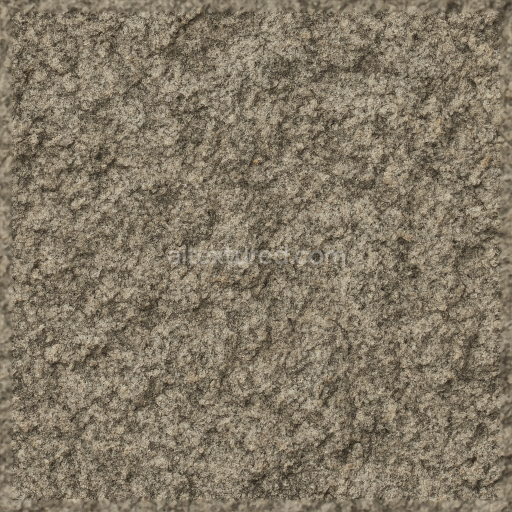This seamless 3D texture represents a granite rocky surface characterized by a rough, natural formation with intricate pitted details and a coarse grain structure. Granite, a crystalline igneous rock, primarily consists of quartz, feldspar, and mica, which combine to form a durable and visually complex substrate. The texture captures the uneven mineral grains and natural fissures that develop through geological processes, showcasing an aged and weathered surface finish. This particular texture emphasizes the raw, unpolished qualities of granite, featuring a matte, coarse surface rather than a polished or brushed finish, which highlights the stone’s natural porosity and subtle erosion patterns.
The surface composition includes tightly interlocked mineral aggregates that create a rugged, irregular pattern typical of granite outcrops and rockfaces. The base color channel (Albedo) reflects earthy tones ranging from muted grays and soft browns to subtle hints of reddish mineral inclusions, reproducing the natural pigmentation caused by iron oxides and other trace elements. The Normal and Height maps define the depth of the coarse grain and pitting, enhancing the perception of a rough, tactile surface with realistic shadows and highlights. Roughness maps are calibrated to convey a predominantly matte finish with variable micro-surface detail, while the Ambient Occlusion map accentuates crevices and recessed areas, lending depth to the texture. Metallic values remain minimal to zero, accurately representing granite’s non-metallic nature.
Rendered at an 8K resolution, this texture provides exceptional detail fidelity, allowing for ultra-high-definition close-up renders without visible pixelation. It is fully optimized for Physically Based Rendering (PBR) workflows and compatible with leading 3D software such as Blender, Unreal Engine, and Unity. The seamless tiling ensures that the texture can be applied across large surfaces without obvious repetition or edge artifacts, making it ideal for architectural visualizations, game environments, and realistic terrain modeling where natural stone formations are required.
For practical application, it is advisable to adjust the UV scale carefully when mapping this texture to large surfaces to maintain the natural grain size and avoid distortion. Additionally, fine-tuning the roughness channel can help simulate different weathering states—from freshly exposed rock to heavily eroded stone. Combining the height map with subtle normal map blending will enhance the perception of depth and irregularity, especially in parallax occlusion mapping setups, providing a convincing tactile granite surface suitable for diverse digital environments.
How to Use These Seamless PBR Textures in Blender
This guide shows how to connect a full PBR texture set to Principled BSDF in Blender (Cycles or Eevee). Works with any of our seamless textures free download, including PBR PNG materials for Blender / Unreal / Unity.
What’s inside the download
*_albedo.png — Base Color (sRGB)*_normal.png — Normal map (Non-Color)*_roughness.png — Roughness (Non-Color)*_metallic.png — Metallic (Non-Color)*_ao.png — Ambient Occlusion (Non-Color)*_height.png — Height / Displacement (Non-Color)*_ORM.png — Packed map (R=AO, G=Roughness, B=Metallic, Non-Color)

Quick start (Node Wrangler, 30 seconds)
- Enable the addon: Edit → Preferences → Add-ons → Node Wrangler.
- Create a material and select the Principled BSDF node.
- Press Ctrl + Shift + T and select the maps
albedo, normal, roughness, metallic (skip height and ORM for now) → Open.
The addon wires Base Color, Normal (with a Normal Map node), Roughness, and Metallic automatically.
- Add AO and Height using the “Manual wiring” steps below (5 and 6).
Manual wiring (full control)
- Create a material (Material Properties → New) and open the Shader Editor.
- Add an Image Texture node for each map. Set Color Space:
- Albedo → sRGB
- AO, Roughness, Metallic, Normal, Height, ORM → Non-Color
- Connect to Principled BSDF:
albedo → Base Colorroughness → Roughnessmetallic → Metallic (for wood this often stays near 0)normal → Normal Map node (Type: Tangent Space) → Normal of Principled.
If details look “inverted”, enable Invert Y on the Normal Map node.
- Ambient Occlusion (AO):
- Add a MixRGB (or Mix Color) node in mode Multiply.
- Input A =
albedo, Input B = ao, Factor = 1.0.
- Output of Mix → Base Color of Principled (replaces the direct albedo connection).
- Height / Displacement:
Cycles — true displacement
- Material Properties → Settings → Displacement: Displacement and Bump.
- Add a Displacement node: connect
height → Height, set Midlevel = 0.5, Scale = 0.02–0.08 (tune to taste).
- Output of Displacement → Material Output → Displacement.
- Add geometry density (e.g., Subdivision Surface) so displacement has polygons to work with.
Eevee (or lightweight Cycles) — bump only
- Add a Bump node:
height → Height.
- Set Strength = 0.2–0.5, Distance = 0.05–0.1, and connect Normal output to Principled’s Normal.
Using the packed ORM texture (optional)
Instead of separate AO/Roughness/Metallic maps you can use the single *_ORM.png:
- Add one Image Texture (Non-Color) → Separate RGB (or Separate Color).
- R (red) → AO (use it in the Multiply node with albedo as above).
- G (green) → Roughness of Principled.
- B (blue) → Metallic of Principled.
UVs & seamless tiling
- These textures are seamless. If your mesh has no UVs, go to UV Editing → Smart UV Project.
- For scale/repeat, add Texture Coordinate (UV) → Mapping and plug it into all texture nodes.
Increase Mapping → Scale (e.g., 2/2/2) to tile more densely.
Recommended starter values
- Normal Map Strength: 0.5–1.0
- Bump Strength: ~0.3
- Displacement Scale (Cycles): ~0.03
Common pitfalls
- Wrong Color Space (normals/roughness/etc. must be Non-Color).
- “Inverted” details → enable Invert Y on the Normal Map node.
- Over-strong relief → lower Displacement Scale or Bump Strength.
Example: Download Wood Textures and instantly apply parquet or rustic planks inside Blender for architectural visualization.
To add the downloaded texture, go to Add — Texture — Image Texture.

Add a node and click the Open button.

Select the required texture on your hard drive and connect Color to Base Color.


